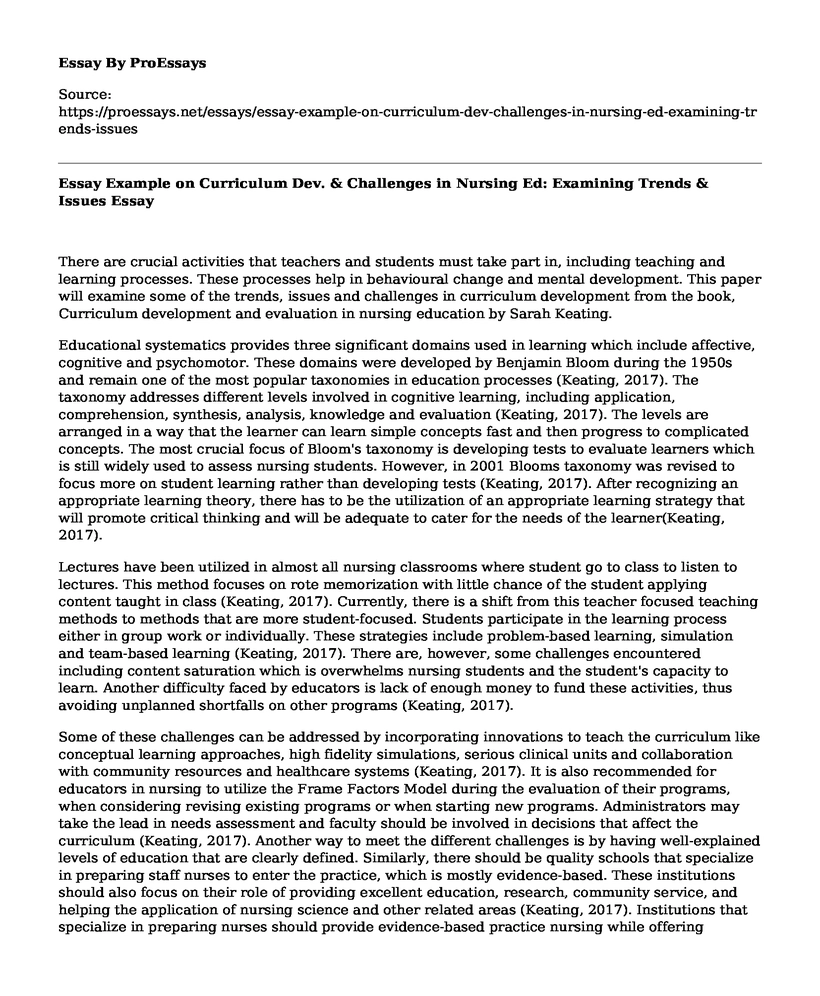There are crucial activities that teachers and students must take part in, including teaching and learning processes. These processes help in behavioural change and mental development. This paper will examine some of the trends, issues and challenges in curriculum development from the book, Curriculum development and evaluation in nursing education by Sarah Keating.
Educational systematics provides three significant domains used in learning which include affective, cognitive and psychomotor. These domains were developed by Benjamin Bloom during the 1950s and remain one of the most popular taxonomies in education processes (Keating, 2017). The taxonomy addresses different levels involved in cognitive learning, including application, comprehension, synthesis, analysis, knowledge and evaluation (Keating, 2017). The levels are arranged in a way that the learner can learn simple concepts fast and then progress to complicated concepts. The most crucial focus of Bloom's taxonomy is developing tests to evaluate learners which is still widely used to assess nursing students. However, in 2001 Blooms taxonomy was revised to focus more on student learning rather than developing tests (Keating, 2017). After recognizing an appropriate learning theory, there has to be the utilization of an appropriate learning strategy that will promote critical thinking and will be adequate to cater for the needs of the learner(Keating, 2017).
Lectures have been utilized in almost all nursing classrooms where student go to class to listen to lectures. This method focuses on rote memorization with little chance of the student applying content taught in class (Keating, 2017). Currently, there is a shift from this teacher focused teaching methods to methods that are more student-focused. Students participate in the learning process either in group work or individually. These strategies include problem-based learning, simulation and team-based learning (Keating, 2017). There are, however, some challenges encountered including content saturation which is overwhelms nursing students and the student's capacity to learn. Another difficulty faced by educators is lack of enough money to fund these activities, thus avoiding unplanned shortfalls on other programs (Keating, 2017).
Some of these challenges can be addressed by incorporating innovations to teach the curriculum like conceptual learning approaches, high fidelity simulations, serious clinical units and collaboration with community resources and healthcare systems (Keating, 2017). It is also recommended for educators in nursing to utilize the Frame Factors Model during the evaluation of their programs, when considering revising existing programs or when starting new programs. Administrators may take the lead in needs assessment and faculty should be involved in decisions that affect the curriculum (Keating, 2017). Another way to meet the different challenges is by having well-explained levels of education that are clearly defined. Similarly, there should be quality schools that specialize in preparing staff nurses to enter the practice, which is mostly evidence-based. These institutions should also focus on their role of providing excellent education, research, community service, and helping the application of nursing science and other related areas (Keating, 2017). Institutions that specialize in preparing nurses should provide evidence-based practice nursing while offering interprofessional services to families and communities. Lastly, there should be health science and academic centres that only specialize in research in nursing and advances in nursing by evidence-based practice and translational science. These centres would also be responsible for testing theories as well as developing new models, concepts and theories (Keating, 2017).
This book offers extensive research on appropriate teaching and learning methodologies that are useful in modern nursing. Most of the texts emphasize evidence-based learning in institutions which all nursing schools should focus on as we prepare for the future.
References
Keating, Sarah. (2017). Curriculum Development and Evaluation in Nursing Education (4th edition). Springer Publishing Company
Cite this page
Essay Example on Curriculum Dev. & Challenges in Nursing Ed: Examining Trends & Issues. (2023, May 08). Retrieved from https://proessays.net/essays/essay-example-on-curriculum-dev-challenges-in-nursing-ed-examining-trends-issues
If you are the original author of this essay and no longer wish to have it published on the ProEssays website, please click below to request its removal:
- Essay Example on Boys & Girls Club: Helping Chicago Youth Reach Their Potential
- Essay Example on Holistic Care for Dementia Patients: Nursing Staff Competencies
- Connor's Parents Dismissed for Failing to Exhaust Claims Under IDEA - Essay Sample
- Essay Example on COVID-19: Deadly Virus Spread by Droplets & Aerosol Transmission
- Essay on Ethiopia Confronts Challenge of Covid-19: Weak Healthcare System and Geography Prone to Spread
- Essay on Developing Children: Maximizing Their Potential Through Learning
- Essay Sample on Social Class & Hidden Curriculum: Jean Anyon Examines Student Experiences







